Ever asked yourself what it would be like to cycle tour in Uruguay? Here’s our experience.
The route
We cycled from Chuy, at the Brazilian border, to Carmelo, by the Rio Uruguay, from the 6th to the 27th of November 2016. We had never been to Uruguay and didn’t have many expectations.
Getting across the border in Chuy was no hassle at all. Chuy itself is like a big tax free shopping centre, not a place where I would have wanted to stay for longer than necessary. The tourist office on the Uruguayan side gave us some useful information and maps. The border checkpoint is a bit outside of the town, and passing with bikes was no problem.
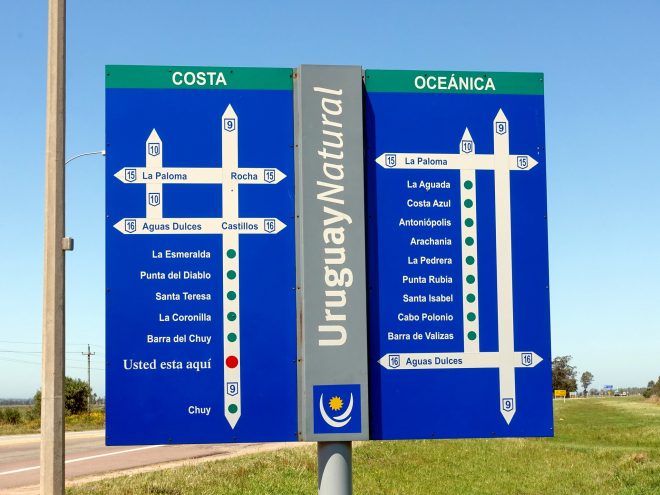
We continued on national road 9, which was not quite as large as the roads in Brazil, and the emergency lane was not always in very good condition, but all in all easy cycling, very flat.
We stopped at Santa Teresa national park where we visited the fort and the beach and spent the night in the campsite (which was almost shut down due to low season and was one of our worst campsite experiences in Uruguay). We continued on route 9 to Castillos, passing by Punta del Diablo (which was also very out-of-season, thus very empty). Castillos is a small town but has some essential services (an ATM, a hotel and a couple of simple restaurants). From there we took route 16 back to the coast, and this route was quieter and nicer than route 9.
It doesn’t follow the shore directly but the beachfront villages were easy to reach on unasphalted, but good roads. Those villages were quite empty and very quiet, but the beaches were nice, especially at Oceanía del Polonia which has nice dunes and a very wild beach. Route 16 continues until La Paloma, which was bigger and livelier than the other villages and also had a couple of bicycle shops (although none of them had a pump with a pressure gauge – I had hoped to check the pressure of my tyres there). We found an open hostel in La Pedrera (Piedra Alta) where we had three quiet rest days.
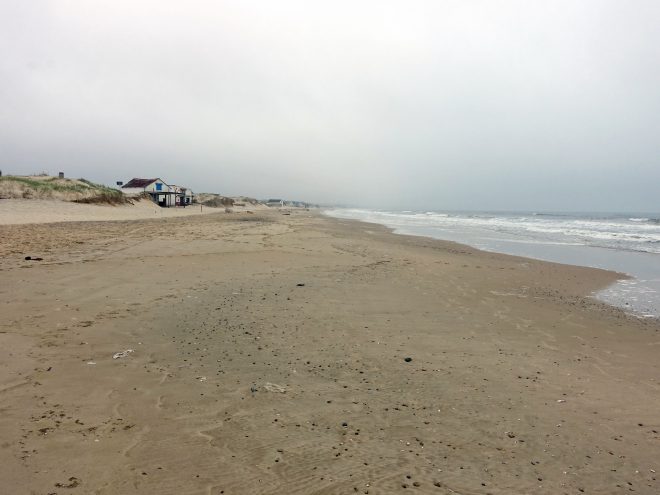
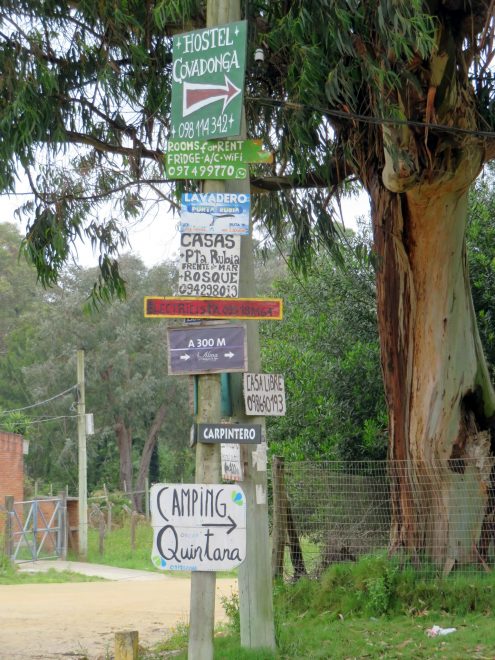
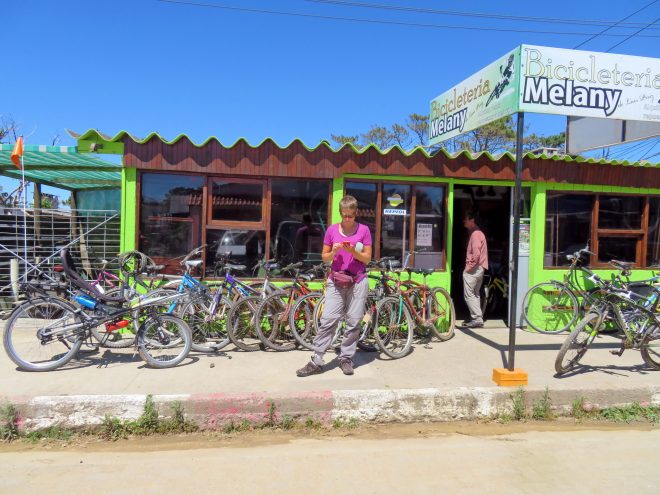
From La Paloma route 15 took us to Rocha, which turned out to be a nice little town with many services, hotels, cafés and so on. From there we took route 9 again. Things started to get slightly hillier, although there’s nothing really high in Uruguay (the highest mountain is just over 500 metres altitude), but it was a welcome change after the flatness of southern Brazil.
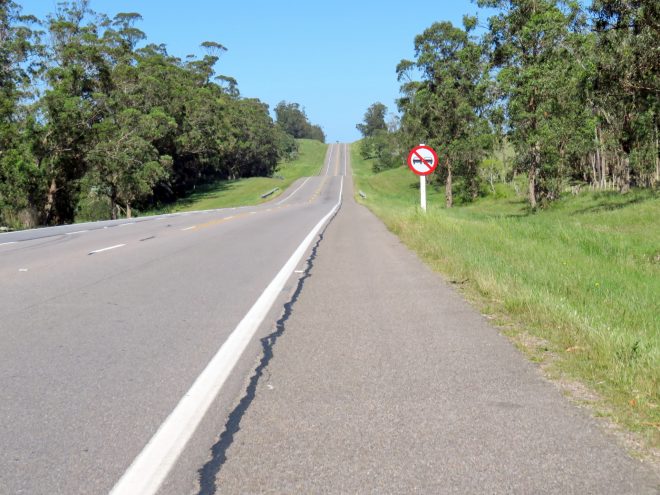
Route 9 was quite busy although we never felt too uncomfortable. We nevertheless left it to the South in the direction of José Ignacio, to take the beachside road to Punta del Este. This road was also quite busy, and got busier the more we approached Punta del Este, but it was nice as it was right next to the sea and beaches.
Punta del Este is a very upscale beach resort, for the rich and the wannabe-rich, and therefore an expensive place. We spent the night at a very nice camp site just before (in San Rafael), and only passed through to get a glimpse of all the hype.
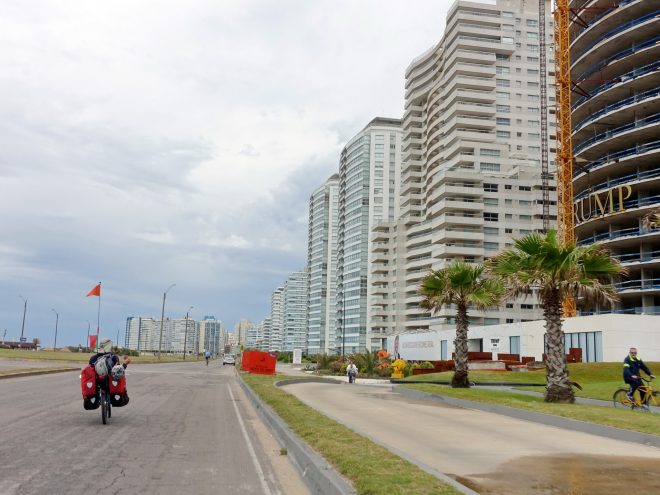
We continued on the Interbalnearia, the large road that connects Punta del Este and the surrounding beaches to Montevideo. At this point the IB was still quiet and we had plenty of space on the side.
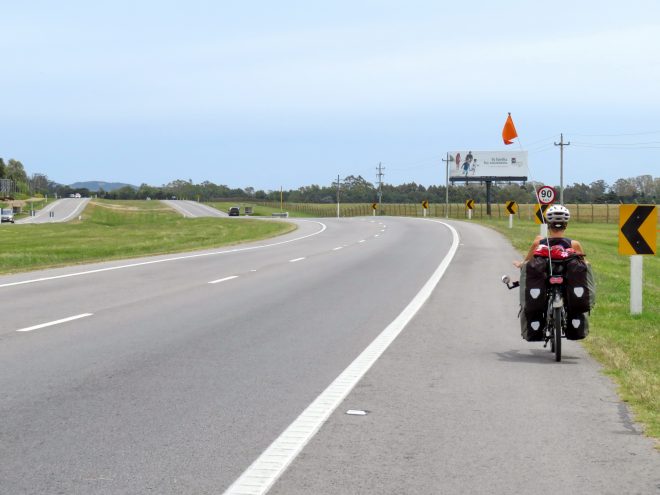
We left it for Piriápolis, a seaside town with a bit of an old-fashioned feel but quieter and nicer than Punta del Este, and with a nice campsite too. From there, the quiet route 10 continued along the beaches, until it joined again the Interbalnearia, which at that point became busier. We left it to explore the villages of Santa Ana and Cuchilla Alta, which had a nice beach for a lunchtime swim. It was worth passing through some of these quiet villages, but unfortunately you always have to get back on the Interbalnearia, which is the only road to cross rivers (there is usually a toll station conveniently located just before the bridge… fortunately bikes don’t have to pay and there is a dedicated lane on the right-hand side).
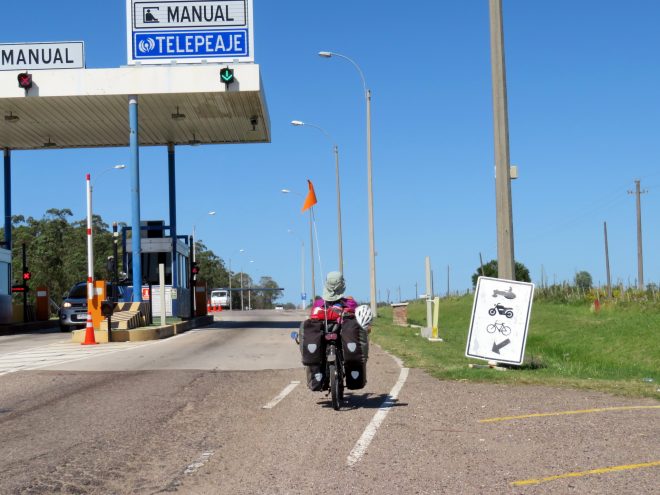
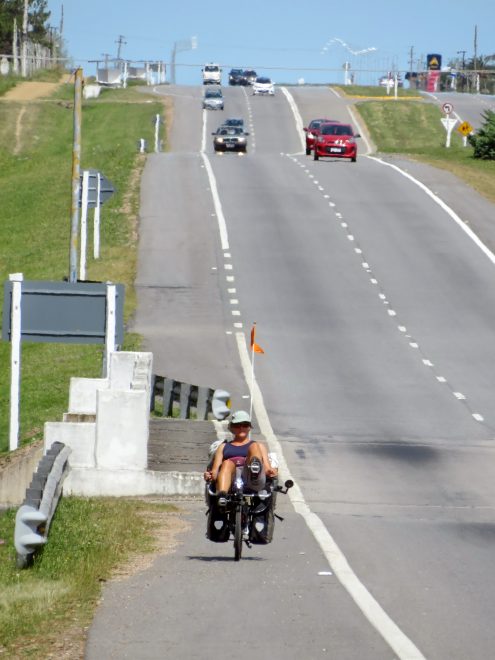
We stopped in Parque del Plata where we camped on the river beach. From there, the IB just got busier up to the point where it got really unpleasant. We also came across several “bicycles forbidden” signs, but as there were no real alternatives we just had to continue (and nobody said anything). Later we knew that there had been an accident on the IB in the recent past (involving a cyclist and a drunk driver…), and the logical reaction to this was to prohibit the road to cyclists…
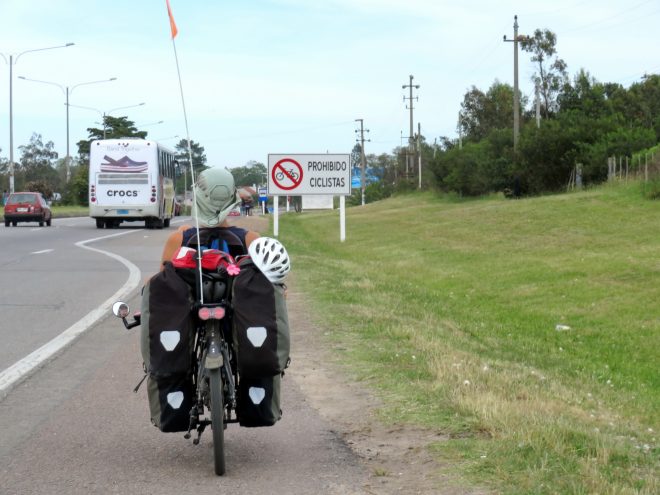
We left the IB after Neptunia, crossing Ciudad de la Costa, but that road was no better and there were many crossings and traffic lights, and this in combination with lots of trucks and lorries (some of which were in a doubtful state) made that part very dangerous. We then tried the Rambla (the road next to the sea) for a while but it also seemed quite dangerous where we were, so we opted for a parallel road (Avenida General Rivera) to get into Montevideo. It was still not nice (cars overtaking too close) but doable, as usual we had to be extra careful with buses and taxis, but in the end we managed to find some very quiet roads and we actually began to enjoy cycling in Montevideo. We stayed with our Couchsurfing host close to Parque Rodo and explored Montevideo mostly on foot, but went along the Rambla by bike once. The Rambla has a few stretches of bicycle lanes, the rest is shared with pedestrians. Montevideo has a few cycle paths in the centre, but they seemed very dangerous to us so we actually preferred cycling on the road, especially on the “30 km/h” roads where cars are meant to share space with bicycles (the reality is sometimes a bit different – most car drivers don’t even seem to see the bicycles although there are quite a few).
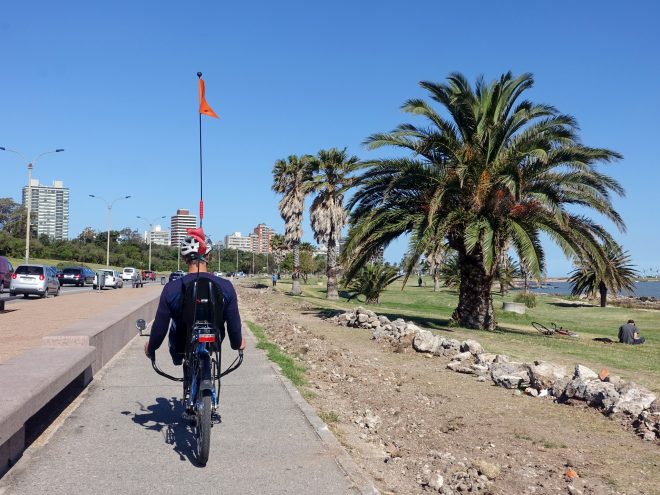
Getting out of Montevideo was straightforward with the good advice of our host, although there was heavy traffic on the outskirts (on the common trunk of national roads 1 and 5). We took Avenida General Rondeau which later joins Avenida Agraciada, and from there it was basically all straight until a left turn where route 1 was signposted. The big road leading out of town (called the RNHB – Ruta Nacional Hugo Batalla) was busy and heavy in truck and bus traffic, but with the use of our rear-view mirrors and some caution it was not too bad. There were also some roadworks under way which slowed down the traffic a lot (to our advantage). The road crossed some poorer neighbourhoods, although they didn’t even remotely look like slums (as a shop owner on the east coast had predicted). As we left the outskirts of Montevideo things got quieter, and then it was back to the good old view of fields, pastures and cows. In the village of Santiago Vázquez cyclists are supposed to join the old national road 1, as the bridge over the river is forbidden for cyclists, but as we couldn’t know this (the sign is placed just before the bridge when there’s no way back anymore…) we continued and were just fine. We crossed Ciudad del Plata on the Ruta 1 Vieja, which was a nicer choice. It was then all straight and flat to Libertad, which has a nice little centre to the north of the main street. We were spontaneously invited by a couchsurfer to camp in his yard, and he also took us to Kiyu, a small village by the Rio de la Plata. For cyclists, this would be a bit of a detour but it would have been a very nice and quiet place to relax (there are a couple of simple campsites).
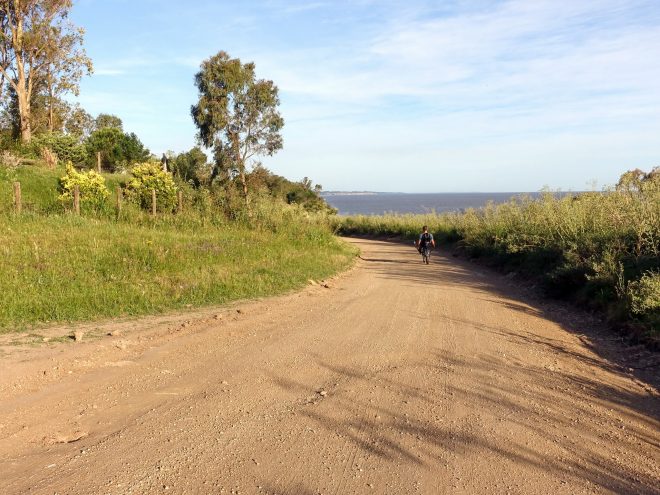
About 17 km after Libertad there was a good service station with a café, Wifi, showers and a picnic site which would have made a good camping spot if we had needed it. From Libertad it was all straight on route 1 to Ecilda Paullier, where we decided to take a non-asphalted road to Nueva Helvecia, starting from the roundabout at the entrance of the village. This road was in good condition and a welcome change to the busier main road (where we were also photographed and filmed all the time from passing cars).
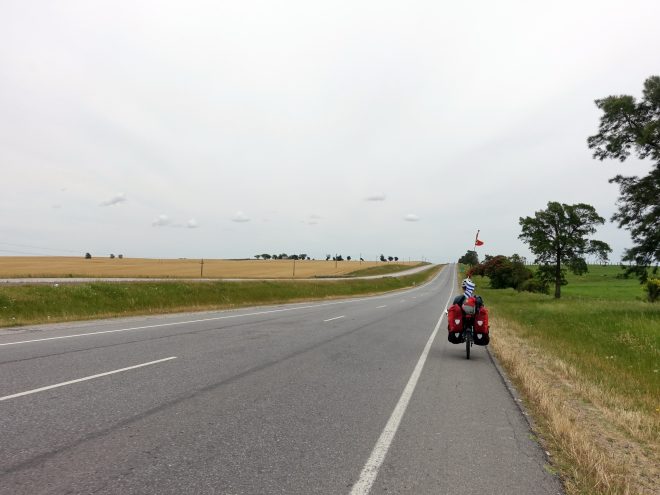
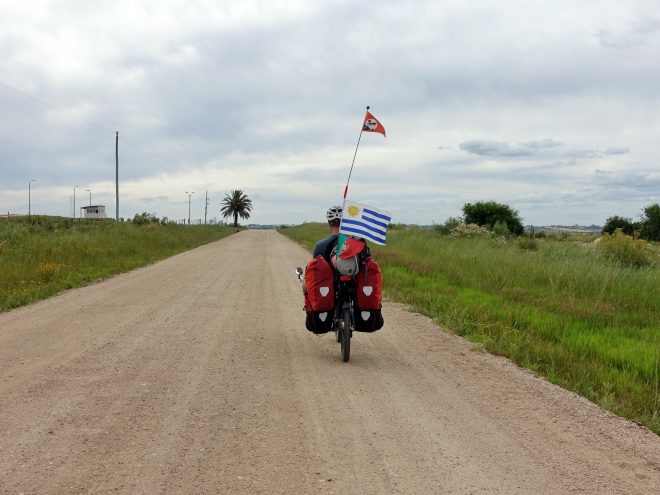
Nueva Helvecia is already close to Colonia de Sacramento, and accommodation prices were accordingly high. We stayed at the cheapest hotel in town and it was actually pleasant. The next day we took a side road out of Nueva Helvecia which later joined route 2, going all straight to Cardona. It was not very busy, and not very interesting either. In Cardona, we continued west on route 2, which by then was larger. Fortunately, there was some kind of truck drivers’ strike, they were all stopped at the exit of Cardona, so we almost had the road to ourselves until José Enrique Rodó, where we spent the night. On the next day, we continued on the same road to Mercedes, this time with a lot more truck traffic. Fortunately, the road had a good shoulder so we were not too uncomfortable.
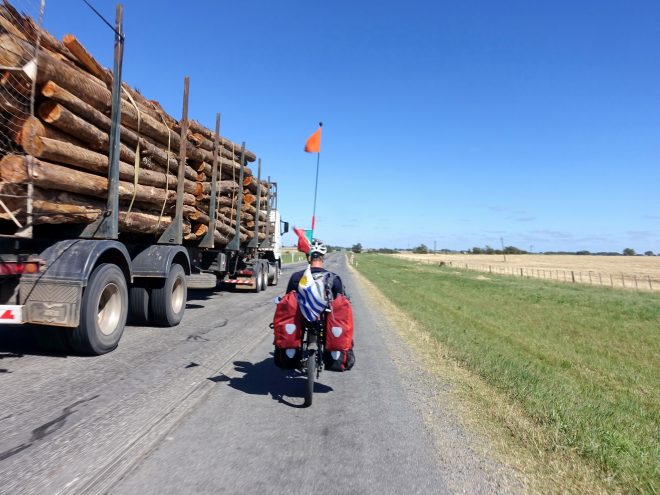
This stretch of road – and all the others to come – were very boring, usually all straight, gently rolling up and down, and nothing else to see except for endless fields. Mercedes was a nice and sleepy little town, everything seemed a bit slow but in a nice way. The people at the tourist office were very helpful, organizing a shower for us (the campsite was closed due to maintenance, we could camp there for free but the showers didn’t work). There was also a nice riverside promenade and a few restaurants in town. Next day we moved on to Fray Bentos, which was a return trip as we didn’t want to leave Uruguay just yet (and we heard that the border crossing is a bridge where bicycles are not allowed). The road was busy with trucks, not very nice nor interesting as the stretches before, but Fray Bentos was well worth the visit. We found a friendly hotel where we could do our laundry, and visited the old industrial site turned into a museum and included in Unesco’s industrial world heritage. We were lucky to get there just in time for the guided tour (in Spanish), which was essential to really understand the place and its context.
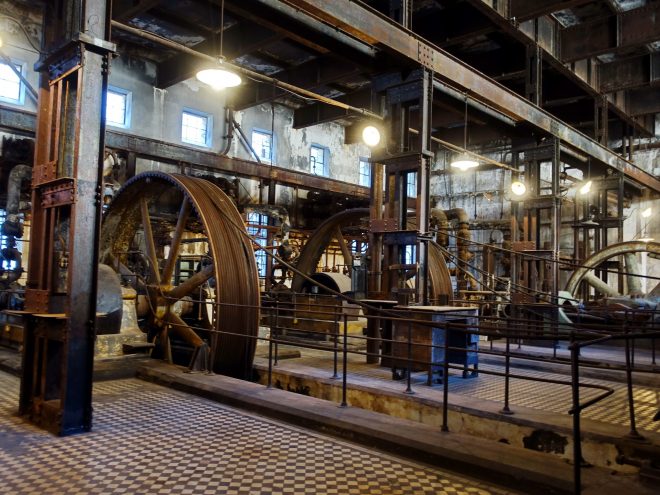
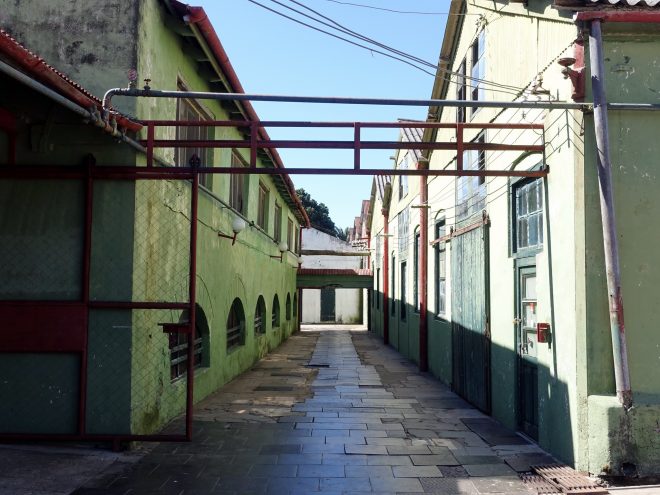
After a night in Fray Bentos we turned back to Mercedes, where we took road 21 to Dolores. It was already much quieter than before, but not more interesting – the usual view of fields and cows. Thus, we were happy to arrive in Dolores, which is an industrial little town with several industrial mills. We stayed at the free municipal camp site and managed again to get a shower organized by the person at the tourist office – she sent us off to the sports centre where they let us use one of the changing rooms and its hot showers. We could even have slept there in case of rain! From Dolores, we continued to Carmelo on route 21, with a lunchtime stop in Nueva Palmira on its nice riverfront picnic site (which was, unfortunately, totally invaded by caterpillars).
We stayed two nights in Carmelo, in a hotel that we had found after going around almost all the hotels and hostels of the town to compare prices. The campsite looked ok but was a bit far from the centre, next to the beach. It’s also possible to sleep in a dormitory of the rowing club. For once, the people at the tourist office were not helpful at all, they advised us to go to a “boutique hostel” that would have cost 100 USD per night…
We spent most of our rest day in our hotel room because of heavy rain, but Carmelo seemed pleasant to walk around and has a nice beach area.
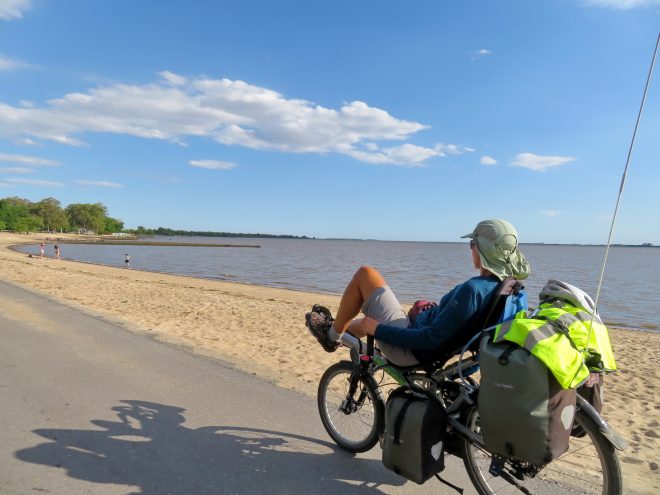
We bought our boat tickets to Tigre (near Buenos Aires) a day in advance, which was probably a good idea as it took at least 20 minutes for the guy to print our tickets and all the necessary paperwork… Leaving on the boat was no hassle, we loaded our bicycles onto the back of the boat and then passed immigration.
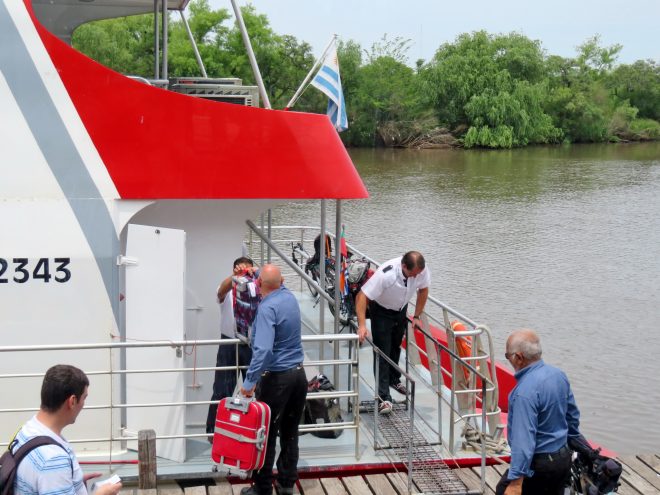
The drivers and the people
Coming from Brazil, we immediately felt a difference in people’s behaviour: we were photographed (without being asked), people stared at our recumbents and even touched them (without asking), and drivers honked at us loudly (mostly in a friendly way but it was still a lot louder than in Brazil). We suddenly felt as if we were back in Spain! Generally, people would not come up spontaneously to talk as much as they did in Brazil, but would rather start a conversation when we stopped in a shop, a café or a petrol station. People were extremely friendly and trying to be helpful, especially west of Montevideo and off the usual backpackers’ East coast track. It seemed very natural for them to help us get a shower, a place to sleep, or any other information. Life struck us a being quite “slow” and relaxed, it seemed to revolve much of the time around sitting somewhere sipping Mate.
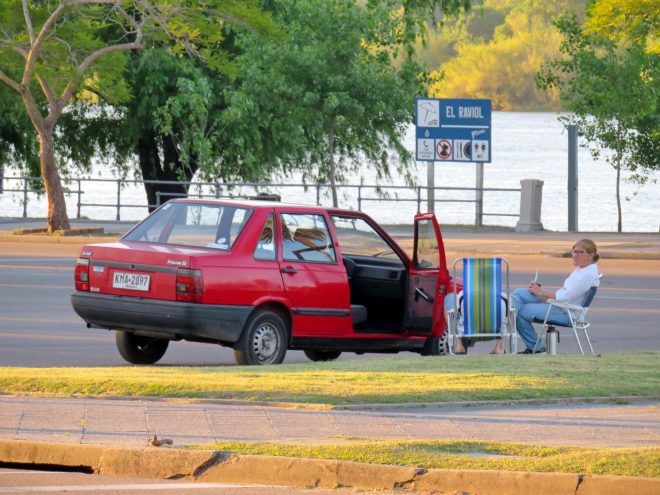
Behind the wheel the average Uruguayan was a bit less relaxed. Cars drove quite fast and although most drivers tried to give us space, we clearly felt that bicycles did not have any priority over motorized traffic. Fortunately, almost all the roads we used had a hard shoulder that was rideable most of the time, so we were never uncomfortable. We did see a passenger bus that had banged head-on into a tree on the other side of the road though, and this doesn’t seem to be exceptional, so we always kept an eye on oncoming traffic.
In Uruguay road bumps are everywhere. Some of them are so brutal that you have to slow down even on a fully-suspended recumbent… in a car you basically have to stop or else you’ll be sent of flying! The other things are little bumps called despertadores – “wake-uppers”, small bumps on the shoulder to alert drivers who may have fallen asleep and are getting off the road. Very annoying for cyclists riding there…
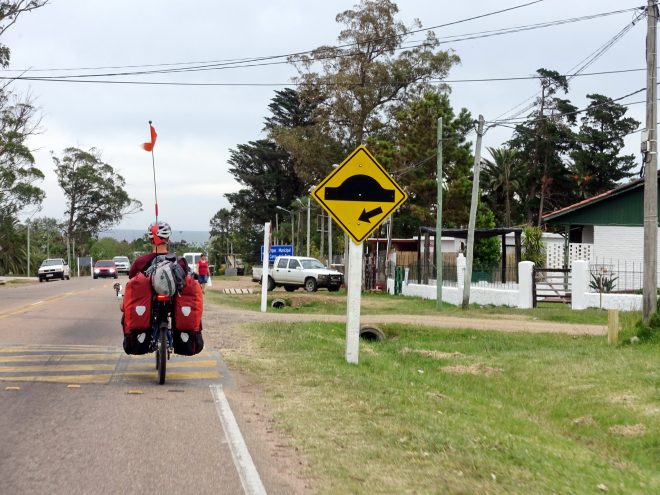
Basic necessities: Water, food and sleeping (and other important things)
We never had a problem with water supply. There was never a very long stretch of road without at least a service station where we could fill up. Every service station also had a machine to get hot water, essential in a mate-drinking country and nice for us for our lunchtime tea.
Food was also easy to get. We always stopped for the night in small towns or villages and there were always shops. Some of them had a long siesta break, but we always managed to find a minimarket even at lunchtime. In more touristic areas there were roadside stalls selling local produce (usually jam and cheese, sometimes potatoes).
The real issue around food was rather the quality. Personally, we like good-quality milk products, such as yogurt and cheese – they were easy to find but almost always of very low quality. The cheese we bought in the East tasted more of chemicals than cheese, and yogurt was only available from the national brand Conaprole and always had lots of additives (sugar, gelatine, corn starch at minimum, sometimes colorants and preservatives). Good bread is also very difficult to find, and compared to Brazil the offer of fruit and vegetables was poor outside of Montevideo. Not easy to find a varied diet for picnics… There were some good bakeries though that sold good sweet baked goods for our second breakfast.
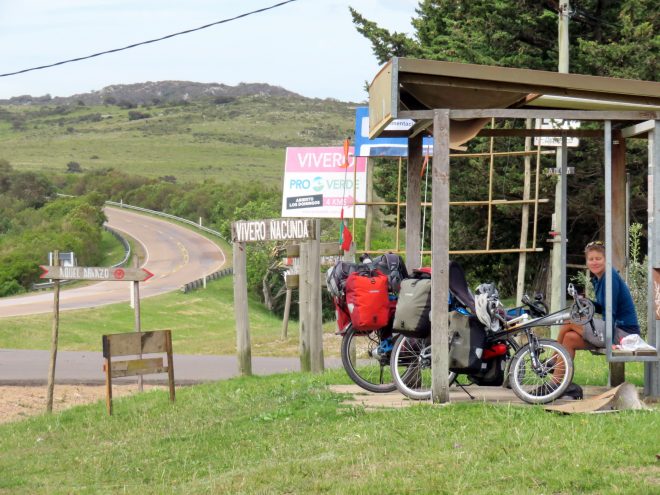
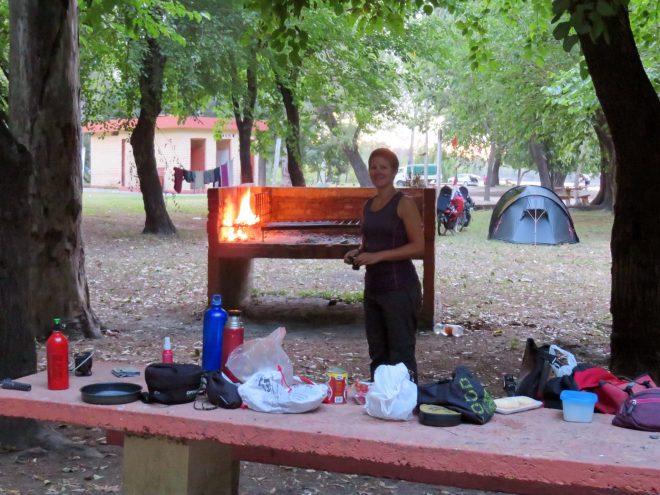
Of course, we tasted several asados – grilled meat. The quality ranged from nothing special to very tasty – it very much depends on the restaurant and the quality of the meat. We did see lots of cows on pastures, so it is possible that most of the beef comes from free-range cows and thus explaining the very good quality.
Pizza and pasta are also very common in Uruguay. We didn’t taste any pizza that was up to Italian standards as we know them… they seemed a bit too “americanized”, but we had some very good homemade fresh pasta which can also be commonly bought in special shops.
We also had chivito a few times – the Uruguayan version of a hamburger, stuffed with all kinds of things. It’s not high gastronomy but it’s filling and therefore good for cyclists!
It was very easy to get fuel for our stove. All gas stations and most supermarkets sell white gas. It’s named Disán and made by ANCAP, and it comes in 1-litre bottles (and occasionally in half-litre bottles). And for those who prefer it, kerosene is sold the same way. We should have stocked up on it before entering Argentina (where white gas is very difficult to get, but you always know better afterwards…).
We slept in campsites, hotels/hostels, and twice with couchsurfers. Campsites are a mixed story: the first one in Santa Teresa national park was almost shut down due to low season, it was difficult to find a decent place for the tent (high grass was growing everywhere), and the showers were unspeakably dirty. The other official campsites we used ranged from almost-perfect (with grills, tables, and clean showers) to very simple municipal campsites. The municipal campsites were both free – one because it was officially closed (Mercedes), and the other one was basically just a corner in the city park that was marked “camping” (Dolores). There were no showers and the toilets had not been cleaned in a long while… In both cases the tourist office arranged for us to take a (free) shower somewhere. We also camped for free in the city park in José Enrique Rodó, after asking the park guardian. And we free camped once on a beach, after asking around in the village about good camping spots.
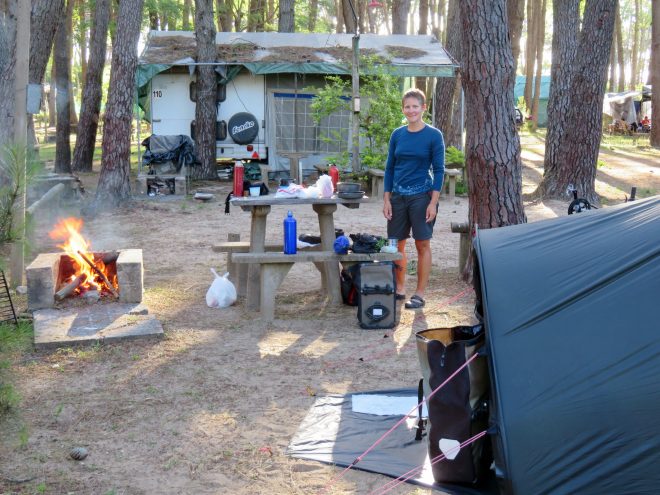
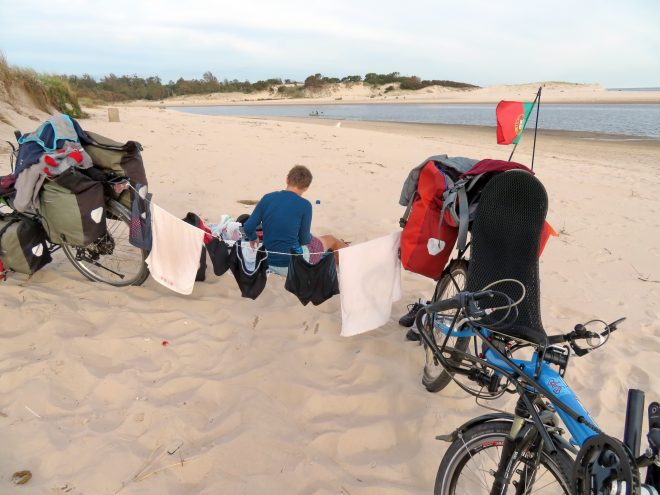
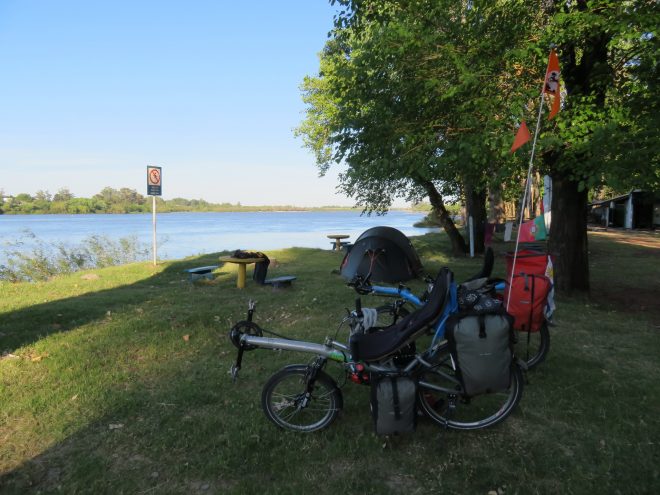
Free camping is widely accepted and done in Uruguay (as long as it’s on public land), and it’s also safe (the country as a whole is very safe). Some gas stations also have nice picnic areas and showers and we have read of people camping there, too. In any case, we felt it was totally normal to ask around in a village where one could camp, and that a solution would always be found.
The hotels and hostels we stayed in were a bit more expensive than in Brazil, but also of much better quality. They all had good hot showers, more or less comfortable beds and were clean, and always had a secure space for our bicycles.
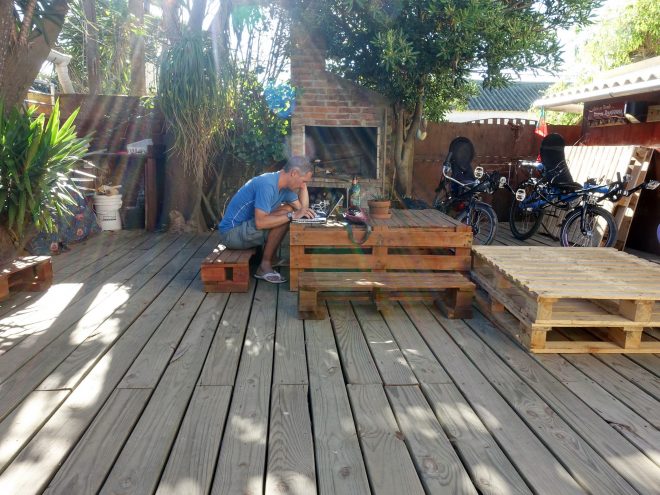
In Uruguay, there’s this funny thing that when you pay in a restaurant with a foreign Visa credit card, you get a 20% discount (we believe it’s also the case for hotels although we’re not sure if it would be 10 or 20%). So, it’s really worth using a credit card there! Especially as it’s not always easy to get money from the ATM… (and it’s expensive, too, as all banks charge around 5 USD). There are two networks – Banred and Redbrou. Banred would never accept our cards (that run on the Plus network), although in theory it should. It would only accept Maestro. Between Chuy and Castillos there were no ATM’s at all (there might be in the summer). We had to use some US Dollars which are widely accepted everywhere, so it’s worth taking dollars as a back-up. ATM’s also give out dollars – useful for those travelling on to Argentina, where Dollars are difficult to get!
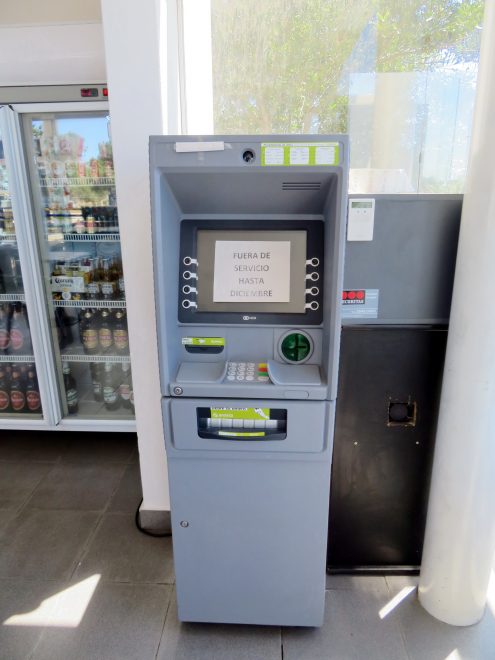
Dangers
Apart from the drivers, we encountered no danger at all. It was a welcome change coming from Brazil, where (real or imagined) dangers seemed to be everywhere. People told us that it was no problem leaving our bikes out in the street with our luggage, and that nothing ever happened here. Well, on a side note, no rule comes without exception: My (beloved) cap was taken from my bicycle while we were inside a hotel for a couple of minutes… reminding us that we were maybe trusting a bit too much.
Dogs are all over the place in Uruguay, many stray dogs and mostly in towns. They were never aggressive or dangerous, they just came to beg for food and we had to chase them away (as opposed to the people here who feed them…). We got some dogs barking at us and a couple of times chasing us away, but nothing really scary.
Orientation
We only used the map they gave us at the Chuy tourist information, to plan which roads to take along the East coast (it was only a schematic map). Otherwise we used OsmAnd and as usual were very happy with it. We also used the app to measure distances to our next stop – distances on road signs were very approximate and sometimes wrong by up to 10 kilometres!
Weather
A bit of everything: sun, heat, rain, thunderstorms, headwind, tailwind, warm winds, cold winds… but overall it was sunny and warm, with cool nights. We again used windguru to predict winds and it proved to be quite accurate.
So, how was it?
Now, this is a difficult one. Uruguay is certainly not the typical bicycle touring country – the roads are mostly boring, there is almost no natural scenery to see (except for the beaches), there are no mountains to speak of, and all you ever see from the road are fields and cows (ok, some horses too). Nevertheless, we think that Uruguay deserves more than just being the transit country wedged between Brazil and Argentina, and if you just go along the East coast between Chuy and Montevideo or Colonia, as most travellers seem to do, you miss out on something. Some villages and towns are surprising: green and forested, with an eclectic mix of housing styles, or with a nice central plaza surrounded by colonial-style buildings. Life is laid-back and relaxed, people are very friendly, and free camping is possible almost everywhere. And another thing – Uruguay is full of cars that you would only find in a museum in most countries. Although we’re not car-fans they make for nice pictures!
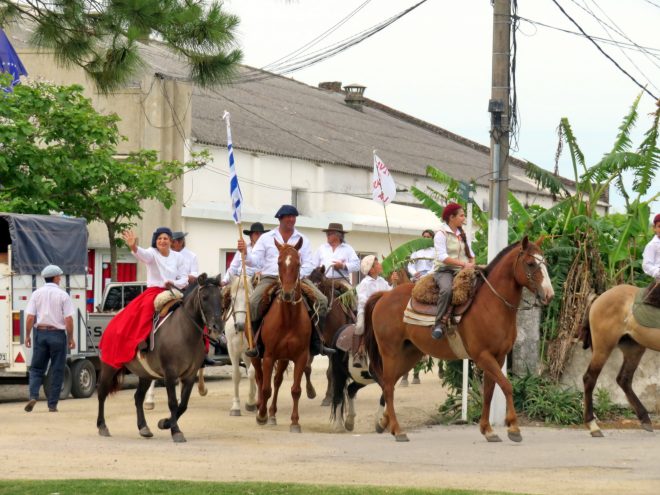
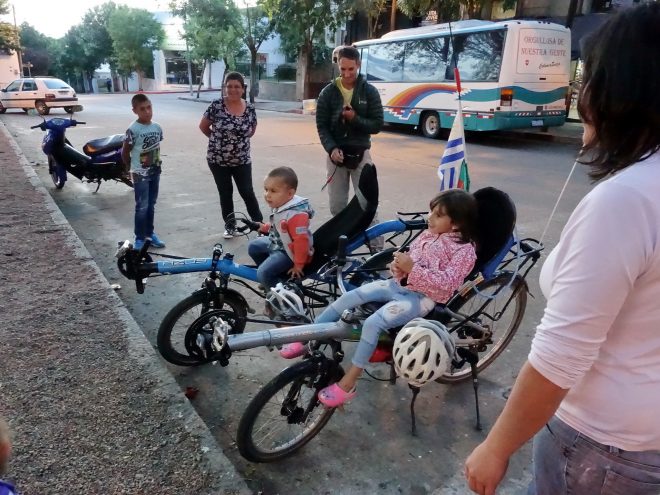
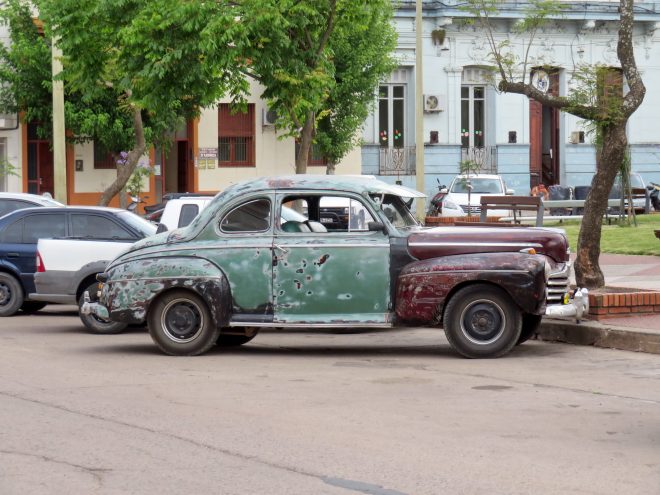
So yes – it was nice, it was comfortable cycle touring, and we’re very happy to have spent a bit more time than strictly necessary in Uruguay by doing a loop in the western part.






















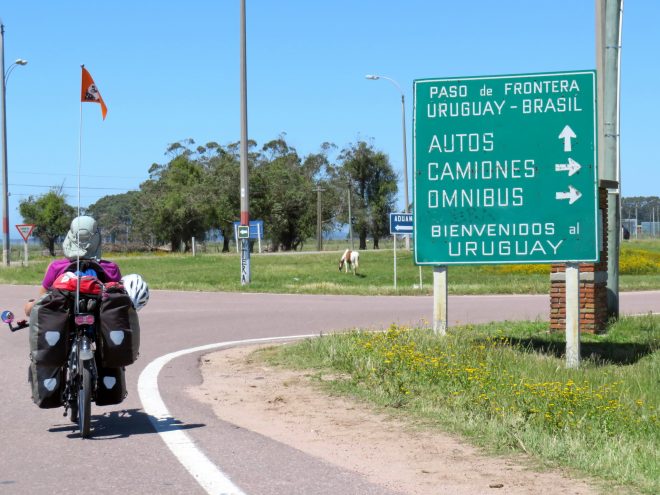
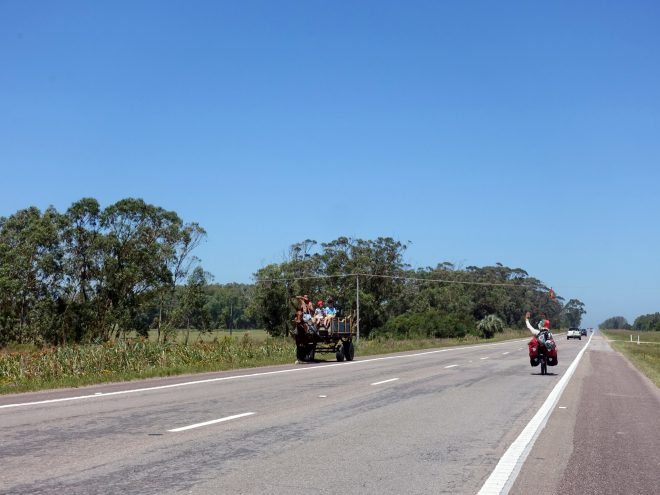
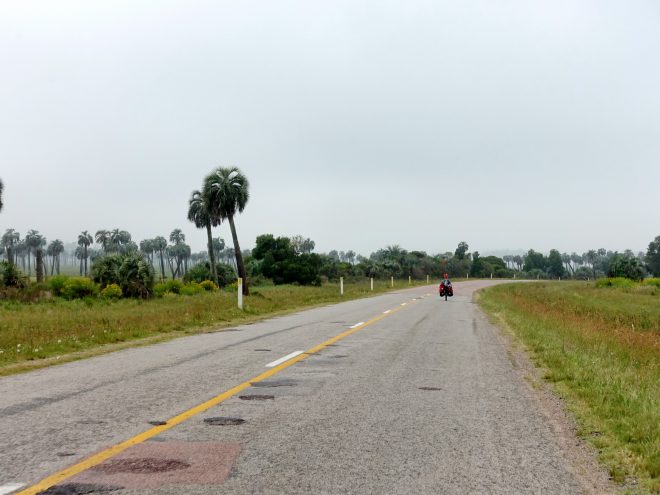
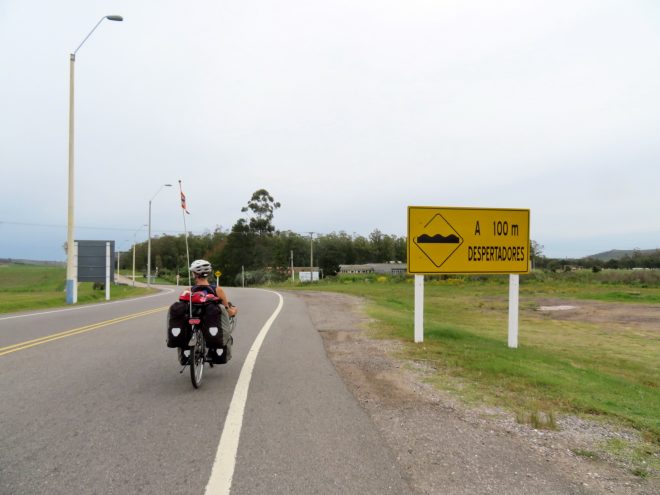
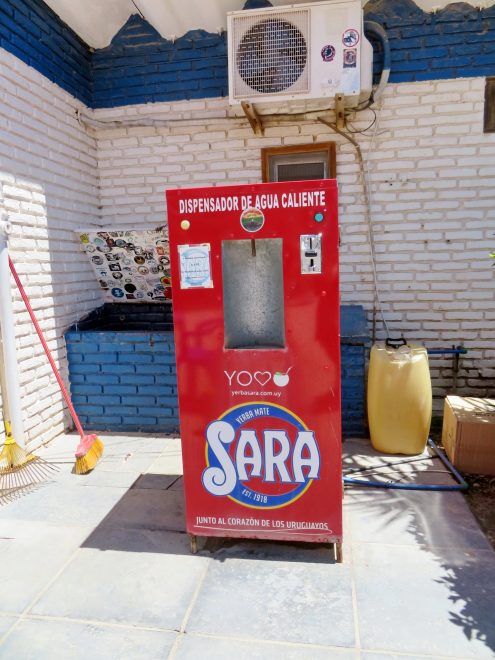
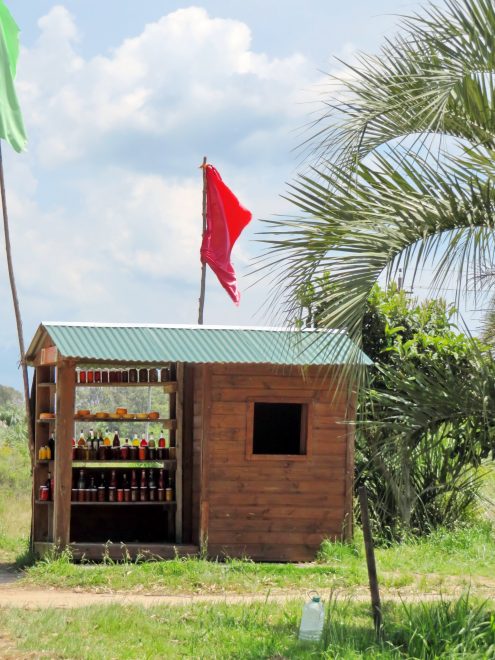
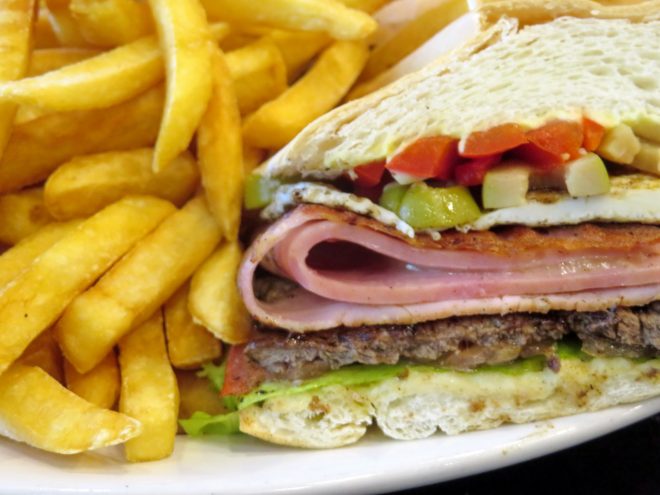
What were the pies like in Fray Bentos? 🙂
Well, they don’t sell Fray Bentos meat pies there… 🙂